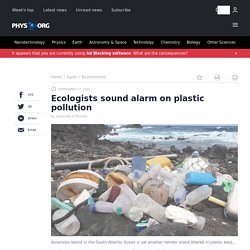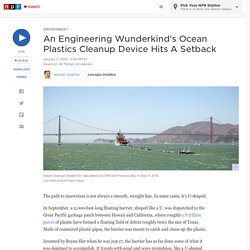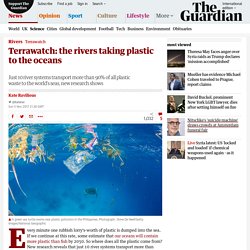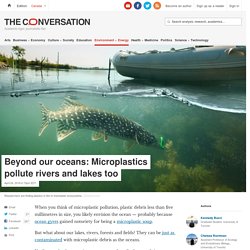

There's an environmental disaster happening in your washing machine. Here's how to clean it up. Coca-Cola and Others Join Project to Create Recyclable Paper Bottles. Photo: Paboco According to the National Oceanic and Atmospheric Administration, scientists estimate that eight million metric tons of plastic—approximately the weight of 90 aircraft carriers—finds its way into the oceans every year.

The Paper Bottle Company (Paboco) wants to help manufacturers and distributors reduce their single-use plastic waste by creating bottles made from degradable plant sugars rather than fossil fuels. BillerudKorsnäs, a paper packaging developer, first started this initiative in 2013, and has been joined by research companies and industry leaders like Avantium and ALPLA. The project proudly announced in October 2019 that Coca-Cola, L’Oreal, and Absolut had joined their efforts. The historic brewery, Carlsberg, has been a long-time partner of the Paper Bottle Project and explained in a press release, “We are working on developing the world’s first ‘paper’ beer bottle made from sustainably-sourced wood fibers that is both 100% bio-based and fully recyclable.”
Ecologists sound alarm on plastic pollution. Ecologists studying the prevalence of plastic pollution in aquatic ecosystems around the world are concerned after measuring the scale of human response needed to reduce future emissions and manage what's already floating around out there.

"Unless growth in plastic production and use is halted, a fundamental transformation of the plastic economy to a framework based on recycling is essential, where end-of-life plastic products are valued rather than becoming waste," says Chelsea Rochman, assistant professor in the Department of Ecology & Evolutionary Biology at the University of Toronto (U of T), and senior author of a study published in Science outlining the accelerating pace with which plastic emissions enter Earth's waterways annually. Ocean Plastics Cleanup Device Hits A Setback. Ocean Cleanup's System 001 was towed out of the San Francisco Bay on Sept. 8, 2018.

JOSH EDELSON/AFP/Getty Images hide caption toggle caption JOSH EDELSON/AFP/Getty Images Ocean Cleanup's System 001 was towed out of the San Francisco Bay on Sept. 8, 2018. The path to innovation is not always a smooth, straight line. Plastic Pollution Reaches Mariana Trench, Deepest Part of Ocean. Microplastics in Great Lakes Tap Water, Beer. Most microplastic harm done at lowest levels of food web, according to analysis. Purdue University scientists led a comprehensive analysis of research concerning the effects of microplastics on aquatic life, with the results showing widely different impacts among different types of animals.

Strong negative effects were particularly apparent for small animals, such as larval fish and zooplankton, a source of food for many species, suggesting serious potential consequences that could ripple throughout the food web. Tomas Höök, an associate professor in Purdue University's Department of Forestry and Natural Resources and director of the Illinois-Indiana Sea Grant College Program, led a team that designed a meta-analysis of research related to the effects of microplastics on aquatic life. The analysis, published in the journal Science of the Total Environment, used results from 43 other studies that each considered the effects of microplastics on consumption of food, growth, reproduction, and/or survival of aquatic animals. The most significant findings included: Here's what's in your bottled water (Marketplace)
Plastic Nanoparticles May Be More Common Than We Think. Sperm whale washed up on Spanish coast was killed by plastic pollution. Terrawatch: the rivers taking plastic to the oceans. Every minute one rubbish lorry’s-worth of plastic is dumped into the sea.

If we continue at this rate, some estimate that our oceans will contain more plastic than fish by 2050. So where does all the plastic come from? New research reveals that just 10 river systems transport more than 90% of the global input of plastic into to the world’s oceans. Rivers are the arteries of our planet. From tiny tumbling streams to vast sluggish deltas, rivers are the link between the atmosphere, land and oceans. By analysing how much plastic is carried by different rivers all over the world, and assessing the amount of littering in areas surrounding rivers, Christian Schmidt, of the Helmholtz Centre for Environmental Research in Germany, and his colleagues have shown that large river systems act as super-highways in transporting plastic to the sea. . • This article was amended on 1 February 2018. . … we have a small favour to ask. Plastic Pollution Coalition - OPEN YOUR EYES - Overview Narrated by Jeff Bridges (2016)
Microplastics - rivers & lakes too click 2x. When you think of microplastic pollution, plastic debris less than five millimetres in size, you likely envision the ocean — probably because ocean gyres gained notoriety for being a microplastic soup.

But what about our lakes, rivers, forests and fields? They can be just as contaminated with microplastic debris as the oceans. Until recently, these environments were described as conduits — ways for plastics to get to the oceans. But now we’re seeing rivers, lakes and soil in a different light, as reservoirs for plastic particles. We now know that agricultural land, surface waters, freshwater lakes and river sediments are also contaminated.